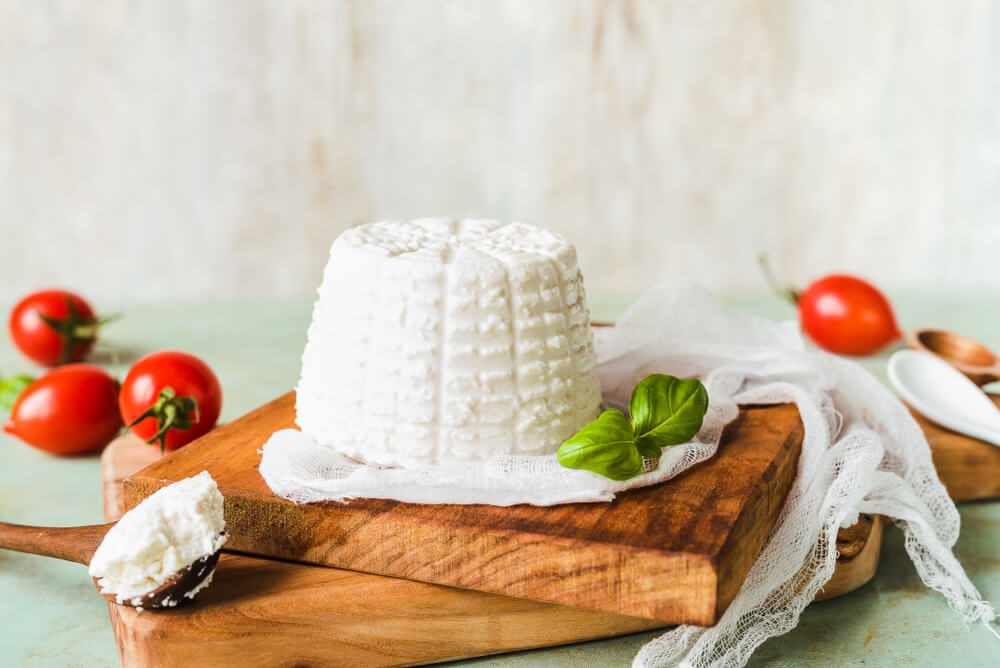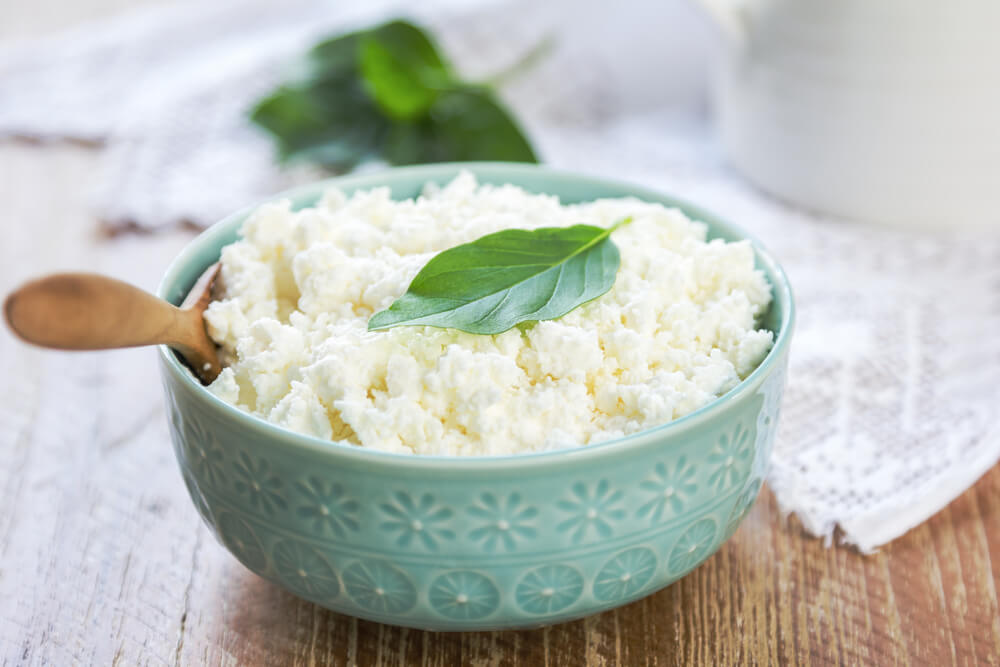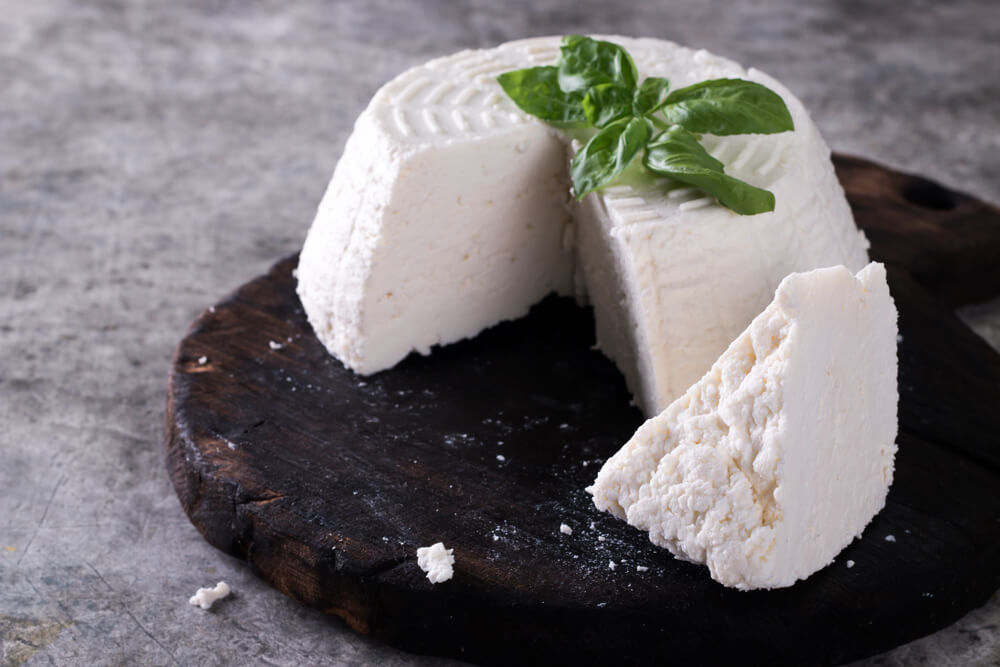

If you’re at all familiar with Italian cooking, you’ve definitely heard about ricotta cheese. It’s one of the most common cheeses used in Italy and for good reason. Ricotta is both widely available and inexpensive.
But, ricotta is a fairly unique type of cheese. It doesn’t pair well with some things you would naturally associate with cheese. In this article, we’ll discuss what to do with ricotta cheese, what it tastes like, and how it’s made.
Let’s jump right in.
Ricotta is a whey cheese. In short, this means it’s made from the byproducts of making other cheeses. You’ve probably heard about separating the curds and whey. When cheese is made, proteins, fats, and sugars clump up to form the curd. The remaining milk solids and water are called whey. Rather than discard whey, it can be processed in several ways to make other types of cheese.
The word ricotta means “recooked” in Italian. That doesn’t mean ricotta cheese is cooked twice, but rather refers to a particular process of reclaiming proteins from whey. Since a large portion of the milk solids are already harvested in the initial cheesemaking, the remaining whey has fewer.
Consequently, ricotta ends up being a smooth and creamy cheese that’s lightly textured. It contains what little fat is left in the whey, which varies slightly based on the type of cheese that was initially made.
But don’t let that fool you. Even though it’s low in fat, ricotta is rich and has the dense mouthfeel of a high-fat cheese.

In the US, and several other countries, ricotta is made from whole milk. The process ends up being some variation of bringing whole milk to a near-boil and adding an acid.
Get ready for some big words.
The acid denatures and precipitates the milk proteins. That just means it turns milk solids into curds. Then, the curds are skimmed off and voila – you’ve got ricotta.
Traditional ricotta is different.
Cheesemakers collect whey which has already been used. This whey already contains some acid, typically rennet. Then the whey is “recooked.” It’s elevated to a temperature just below boiling but far above the temperature used to make the initial cheese. That’s where the recooking terminology comes from. Heating the whey creates, curds. The curds are turned into ricotta.
The key difference is in using whey over whole milk. Sometimes, milk or cream is added to the whey to make up for the absence of milk solids but whey is still the main ingredient.
Simple, fresh ricotta has a mild, slightly nutty flavor. Its thick and creamy texture is punctuated by tiny granules throughout. Due to its neutral flavor, ricotta works well in both sweet and savory dishes. But, there’s another version of ricotta. Ricotta salata.
Ricotta salata is, in essence, aged ricotta. Whereas ricotta has a short shelf life, it can be pressed, dried, and salted to make a much more assertive cheese. Think of fresh ricotta as a freshman, he just got started and he’s looking to make friends with anyone. It’s easy to get along with fresh ricotta, since it’s not very opinionated or overpowering.
Ricotta salata is like a senior. It’s been around the block and it’s got a tight-knit social circle already. Ricotta salata has a lot more character than ricotta and it’s not appropriate for sweet dishes. It retains some of the markers of fresh ricotta, but it’s closer to a salad-friendly cheese, such as cotija or feta.
While harder to pair, ricotta salata is still an outstanding cheese – if a bit harder to come by than fresh ricotta.
As an Italian cheese, you’ll most often see it in Italian dishes.
A dish that showcases ricotta in a big way is traditional Italian lasagna. The ricotta, egg, and herb blend is what gives lasagne its characteristic substance and really brings the dish together.
Ricotta is also used in many other pasta dishes to provide a creamy base. However, it also shines in a variety of desserts. Cannoli is one such dish. Sweetened ricotta perfectly offsets the fried crispy cannoli and it’s easy to see why it’s one of the most popular Italian desserts.
Ricotta salata is often found in salads (don’t confuse the name, salata means “salted” and has nothing to do with salad). And other varieties of varying flavor profiles are used for specialized dishes.
Ricotta is also sometimes used to add substance and texture to baked goods. Ricotta can find a place in pound cake, cheesecake, and even pancakes.
It’s a supremely versatile type of cheese due to the minimal fermenting that gives it a characteristically mild flavor. It’s similar in a lot of ways to mascarpone, although it has significantly less fat.
Another very Italian use of ricotta is in one of their many Easter pies.
Easter Sunday is extensively observed in Italy and special pies are made for the occasion. Ricotta, combined with eggs and grains and then baked until firm, forms the main ingredient of the Neapolitan pastiera – one such pie.
If you want to replace mayonnaise in sandwiches or most, ricotta is an excellent choice. A thin layer of ricotta makes an exquisite addition to a grilled cheese sandwich, for instance.
Lastly, ricotta is often featured in hors d’oeuvres. You can pair it with figs or spread it on toast with a drizzle of honey for quick and easy tapas.
There are hundreds of potential suggestions for what to eat with ricotta cheese. But, if you want a dish that really makes ricotta shine, try a good lasagna or some cannoli.

You know about ricotta salata and fresh ricotta, but there are several other kinds as well. Each adds a unique twist of flavor to the neutral fresh ricotta. Mostly, the variations involve some degree of aging and salting.
Ricotta infornata is a baked variety. Soft ricotta is baked at medium temperatures until it develops a lightly charred crust. It’s often used as a spread for canapés, similar to baked brie.
Ricotta affumicata involves smoking ricotta until it acquires a smokey taste. Smoked ricotta develops a brown crust and it becomes firm enough to eat as a sliced cheese.
Ricotta forte is the granddaddy of the ricotta family. It’s made by combining ricotta from various types of milk, including cow, sheep, and goat. Then, the cheese is salted and allowed to age for a year. During that time, it’s often mixed and the result is a creamy brown paste. It has a strong flavor and pungent odor and it’s often either used as a spread or used in sauces to add character and depth of flavor.
Ricotta is one of the most adaptable types of cheese you’ll come across. Need a great way to make your pasta creamier? Ricotta’s got your back. Want to make a creamy filling for a dessert? You guessed it – ricotta. Once you try it, you’ll realize why it’s such a culinary staple.
Head over to our blog for more advice on how to enjoy fresh ingredients and find the best recipes for them.
Stubborn Seed is the brainchild of Top Chef Season 13 winner, Jeremy Ford. If you’re looking for the best fresh food restaurant in Miami, stop looking. Book a table or a private event right now at Stubborn Seed.